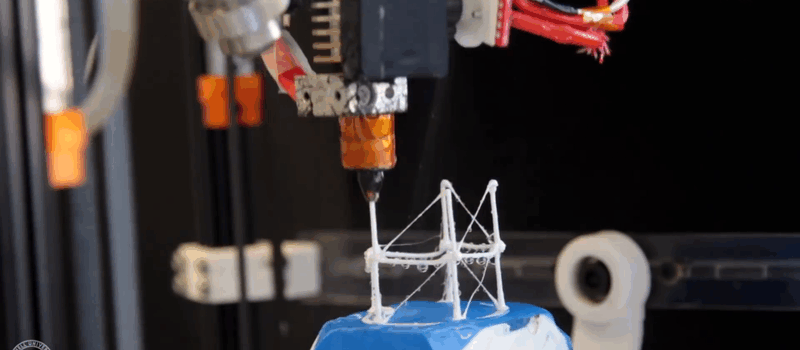3D printing is supposed to be about rapid prototyping. Design, print, use, re-design, print, test — iterate until happy. But when you’re laying down filament at 60 mm/s, it can seem anything but rapid.
[Huaishu Peng], [Rundong Wu], and their supervisors at Cornell have come up with a 3D printer that can print almost as fast as you can model, and is able to add and subtract from the model on the fly. The goal is to get an initial model out so quickly that designing and printing can be truly interactive. They look to have succeeded — check out the video below.
3ders.org has a brilliant writeup of the machine that you should also go read once the video’s magic has worn off. There’s a lot going on to make this all work. The printer adds two extra degrees of freedom and a cutter head so that it can make additions and subtractions from the side, and is not constrained to layer-by-layer construction. To get the ABS to cool fast enough to make solid strands, water jets mist it down to temperature just after it’s printed.
The software running the machine is also incredible. It has the ability to pause while you pull the model off the machine and test it for fit. It then resumes as if nothing had happened. The part is attached to a fixture — we’re guessing that it’s registered well-enough that it knows where the object is. The CAD software also needs to be able to mark deletions as well as additions. And don’t even get us started on the path-planning nightmare!
You might look at these models and say they look rough. They’re meant to be — it’s just a quick draft after all. That this entire system works at all is a marvel. We’ve written on alternative slicers before, and even covered wireframe printers but this research project takes both cakes at once. Cool stuff!
Thanks [Cheng] for the tip!

















Hmm: I wonder how much that mist actually cools the hot end, because it’s going to be hot enough for the leidenfrost effect to occur if the surface were hoizontal. In this case, I wonder if it’s not going to very quickly vaporize part of it, but not all of the droplet, which would be forced away.
If you look at the angles of the sprays, their for flash cooling the filament below the nozzle, not for cooling the hot-end.
Not sure I see the point. The resulting parts look uselessly flimsy.
Yes, but you get to hold them in your hand, put them where the final part will go and do a sanity check for shape and scale before committing to a full print. This is the equivalent of making a part out of cardboard before you start cutting steel – it’s just getting a feel for how the finished object will look.
I always model the “surroundings” as well. E.g. I model the raspberry pi when I design a case. Then looking at the CAD allows me to perfect the item I’m designing before committing to a print. This works quite well.
I agree that modeling the environment is great for scale and ‘fit.’ However, that is not the fast and loose process they are trying for here. Sometimes you just want a mockup, you want a gesture sketch. You want to explain what you’re trying to do to a colleague and the only way that will work is something physical in their hands.
This is awesome
As a first step in 5-axis 3D printing and fast rapid prototyping this is amazing. Up the resolution a bit and add shell printing on the model and you can print fast, strong and do it on the fly. This s**t is amazing work.
Heck, skip shell-printing entirely and see if a simple inkjet-compatible thermoplastic exists that can be used in sheet form with a simple vacu-forming station. Thirty seconds to print a shell, if appearance matters, and run it through a secondary machine to skin the model. This won’t work for every model, obviously, but it would work for a great many.
Same concern here. Not only do the resulting… things… hopelessly flimsy and much too rough for any real dimension-checking (useless for fine fit check, and if you need cm-levels checks, you are doing it wrong…) and worse than that, without any realistic perspective of notably improve. “Doodling” 3D-printer pens are really not new, and have stayed consistently useless. To produce anything meaningful one would need an entirely new deposition technology – pulling a single strand of filament through the air is not gonna do it.
Ehhh, can’t write coherently. Need more coffee (and an edit button…)
Doozers would be proud.
The prints remind me of a kids drawing.
It makes me think that it would be cool if slic3r had a wireframe slice setting, for when we need to see if something fits before we commit babysitting time and fillament. I already often do a footrint test print for fit.
It’s the 3D printing version of https://hackaday.com/tag/3d-printing-gun/
I don’t get the auto print “feature”.
That’s like a text editor sending every word you type to a printer. What’s the use of that?
While modeling 3D stuff, I usually estimate the dimensions of parts that I have not yet measured, make them parametric. Later, I take out my calipers, determine those missing dimensions and enter them. Their integration software would waste time and filament on parts I knew to not fit properly instead of waiting until I consider the part ready.
Snarkers gotta snark. It doesn’t matter how practical the result is–this project is effing brilliant.
However, the retractable cutting blade is kinda wobbly.
Eventually to be replaced by a laser. B^)